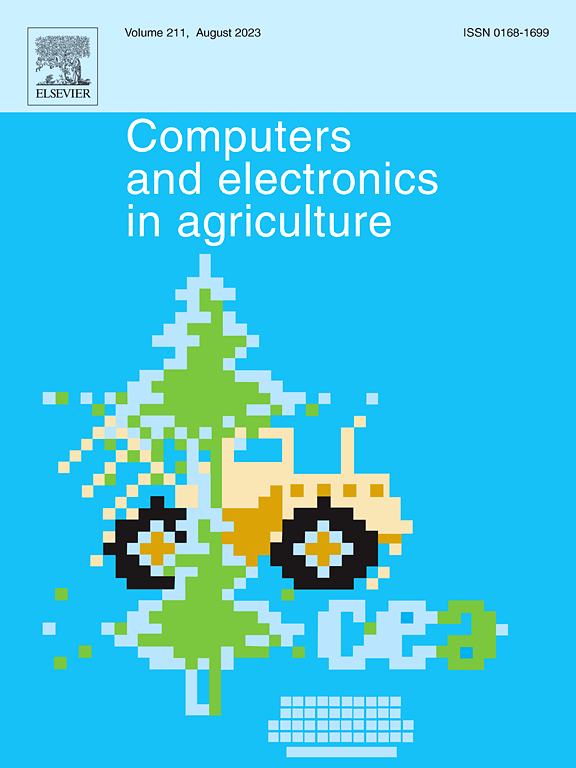基于无人机的棉花冠层叶绿素含量时序监测平台筛选黄萎病抗性种质
IF 8.9
1区 农林科学
Q1 AGRICULTURE, MULTIDISCIPLINARY
引用次数: 0
摘要
黄萎病(Verticillium wilt, VW)是一种严重危害棉花产量和纤维品质的病害。高效、准确地筛选抗vw品种对棉花育种和生产至关重要。然而,传统的识别方法,如人工观察,效率低,成本高。无人机(UAV)和遥感技术为大田作物抗病种质筛选开辟了新思路。本研究利用无人机多光谱平台采集了150个不同VW抗性棉花品种的5个生育期数据。通过分层分割分析,确定归一化植被指数(NDVI)是叶绿素水平的可靠预测因子。我们进一步比较了4种叶绿素监测的深度学习模型:1D-CNN、CNN-BiLSTM、CNN-BiLSTM- adaboost和CNN-BiLSTM- attention,其中CNN-BiLSTM- attention模型表现最好(R2 = 0.92)。采用最优模型对单期和多期叶绿素进行VW侵染程度的反演,结果表明,单期和多期叶绿素对VW侵染程度的反演效果最好,R2最高,为0.96。采用多时期叶绿素含量多维聚类方法筛选不同棉花抗vw种质,结果表明ISODATA聚类方法优于K-means、K-means ++和GMM方法。本研究强调,将无人机多光谱平台与准确的叶绿素反演模型相结合,可以实现棉花田间VW侵染的高通量评估,为棉花VW抗性种质筛选提供有力工具,从而支持棉花育种工作。本文章由计算机程序翻译,如有差异,请以英文原文为准。
Screening Verticillium wilt-resistant germplasm by monitoring the time-series chlorophyll content of cotton canopies via a UAV-based high-throughput platform
Verticillium wilt (VW) is a highly detrimental disease of cotton that causes significant reductions in yield and fiber quality. Efficient and accurate screening of VW-resistant varieties is essential for cotton breeding and production. However, traditional identification methods, such as manual observation, are inefficient and costly. Unmanned aerial vehicle (UAV) and remote sensing technologies have opened new insights into the screening of field crops for disease-resistant germplasm. This study utilized a UAV multispectral platform to collect data from five growth stages of 150 cotton varieties with different VW resistances. The normalized difference vegetation index (NDVI) was identified as a reliable predictor of chlorophyll levels through hierarchical segmentation analysis. We further compared four deep learning models for chlorophyll monitoring: 1D-CNN, CNN-BiLSTM, CNN-BiLSTM-Adaboost, and CNN-BiLSTM-Attention, with the CNN-BiLSTM-Attention model performing best (R2 = 0.92). The optimum model was then used to invert the extent of VW infection using single- and multi-period chlorophyll, and the latter was found to have the best results with the highest R2 value of 0.96. Multidimensional clustering of chlorophyll content over multiple periods was used to screen different cotton VW-resistant germplasm, and the ISODATA cluster method outperformed the other three methods (K-means, K means++, and GMM). This study highlights that combining a UAV multispectral platform with an accurate chlorophyll inversion model can enable high-throughput assessment of the cotton VW infection in the field, providing a powerful tool for screening cotton VW-resistant germplasm and thus supporting cotton breeding efforts.
求助全文
通过发布文献求助,成功后即可免费获取论文全文。
去求助
来源期刊

Computers and Electronics in Agriculture
工程技术-计算机:跨学科应用
CiteScore
15.30
自引率
14.50%
发文量
800
审稿时长
62 days
期刊介绍:
Computers and Electronics in Agriculture provides international coverage of advancements in computer hardware, software, electronic instrumentation, and control systems applied to agricultural challenges. Encompassing agronomy, horticulture, forestry, aquaculture, and animal farming, the journal publishes original papers, reviews, and applications notes. It explores the use of computers and electronics in plant or animal agricultural production, covering topics like agricultural soils, water, pests, controlled environments, and waste. The scope extends to on-farm post-harvest operations and relevant technologies, including artificial intelligence, sensors, machine vision, robotics, networking, and simulation modeling. Its companion journal, Smart Agricultural Technology, continues the focus on smart applications in production agriculture.
 求助内容:
求助内容: 应助结果提醒方式:
应助结果提醒方式:


